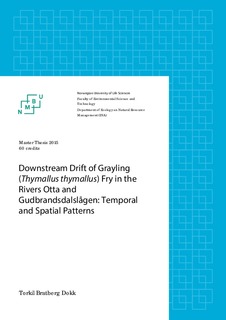| dc.contributor.author | Dokk, Torkil Bratberg | |
| dc.date.accessioned | 2015-11-02T14:43:08Z | |
| dc.date.available | 2015-11-02T14:43:08Z | |
| dc.date.copyright | 2015 | |
| dc.date.issued | 2015-11-02 | |
| dc.identifier.uri | http://hdl.handle.net/11250/2359016 | |
| dc.description.abstract | The object of this study was to investigate drift of grayling fry in two large Norwegian inland rivers. Previous studies of migrations and area use of grayling in the Otta-Gudbrandsdalslågen river system made the area well suited for further studies. There is little knowledge about the migrations of year-of-young grayling in such systems, and how these migrations influence the distribution of adult fish.
To investigate and compare the drift between Otta and Gudbrandsdalslågen rivers, drift traps were made, and distributed over four stations at different depths in both rivers in 2014. The traps was checked and the contents sorted every 24 hour period, with 12 hour sampling periods at selected stations to explore potential diel patterns in the drift. The captures of drifting larvae were modelled to investigate the influence of different environmental factors and the results were compared between rivers.
Drift of grayling larvae was observed over a short time period of 12-13 days. The larvae mainly drifted at night, deep in the water column. The sum of degree days (°D > 5° C) was the environmental factor best explaining the drift of grayling larvae. There were between-river differences in both the spatial distribution of the drift and observed growth in larvae during the study period. Grayling larvae drifted through the whole study area in Otta, while drift only was observed at the uppermost and lowest station in Lågen. The length of trapped grayling larvae in Otta stayed the same during the study period, while growth was recorded in Lågen, possibly due to the differences in distribution of nursery areas between the rivers.
The observations of drift made in this study are related to the early life history strategies of the grayling in the river system. The grayling is adapted to ensure drift dispersal of larvae from high velocity spawning sites to slow flowing nursery habitat. This can be hypothesized to be an underlying factor in the motivation behind the potamodromous migration cycle of the grayling in the river system. Hydropower development and loss of connectivity will arguably influence the drift of larvae and the motivation behind migration of grayling, possibly changing the selection from favoring migration towards stationary behavior. | nb_NO |
| dc.language.iso | eng | nb_NO |
| dc.publisher | Norwegian University of Life Sciences, Ås | |
| dc.rights | Navngivelse 3.0 Norge | * |
| dc.rights.uri | http://creativecommons.org/licenses/by/3.0/no/ | * |
| dc.subject | Grayling | nb_NO |
| dc.subject | Drift | nb_NO |
| dc.subject | potamodomy | nb_NO |
| dc.subject | Migrations | nb_NO |
| dc.subject | Hydropower | nb_NO |
| dc.title | Downstream drift of grayling (Thymallus thymallus) fry in the rivers Otta and Gudbrandsdalslågen : temporal and spatial patterns | nb_NO |
| dc.type | Master thesis | nb_NO |
| dc.subject.nsi | VDP::Agriculture and fishery disciplines: 900::Agriculture disciplines: 910::Management of natural resources: 914 | nb_NO |
| dc.source.pagenumber | 59 | nb_NO |
| dc.description.localcode | M-NF | nb_NO |

